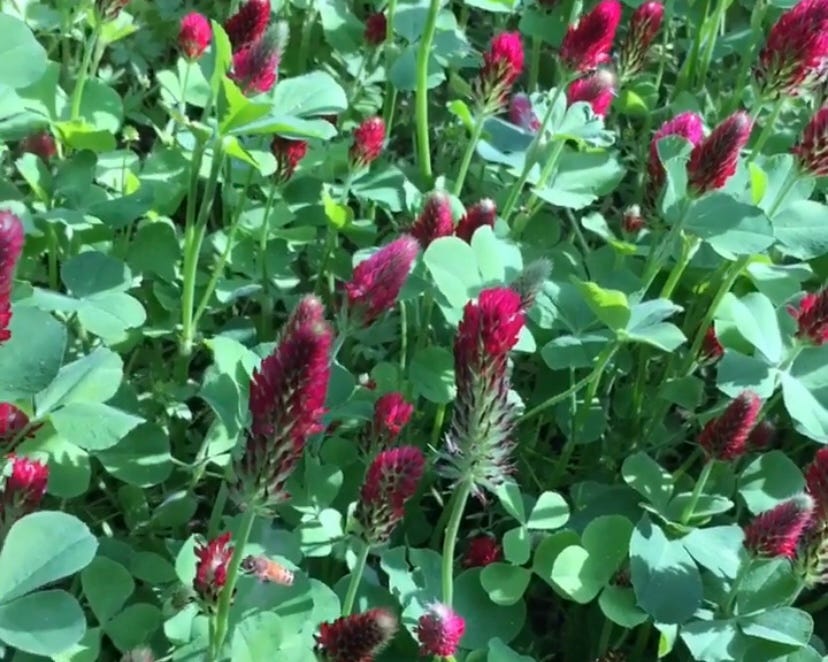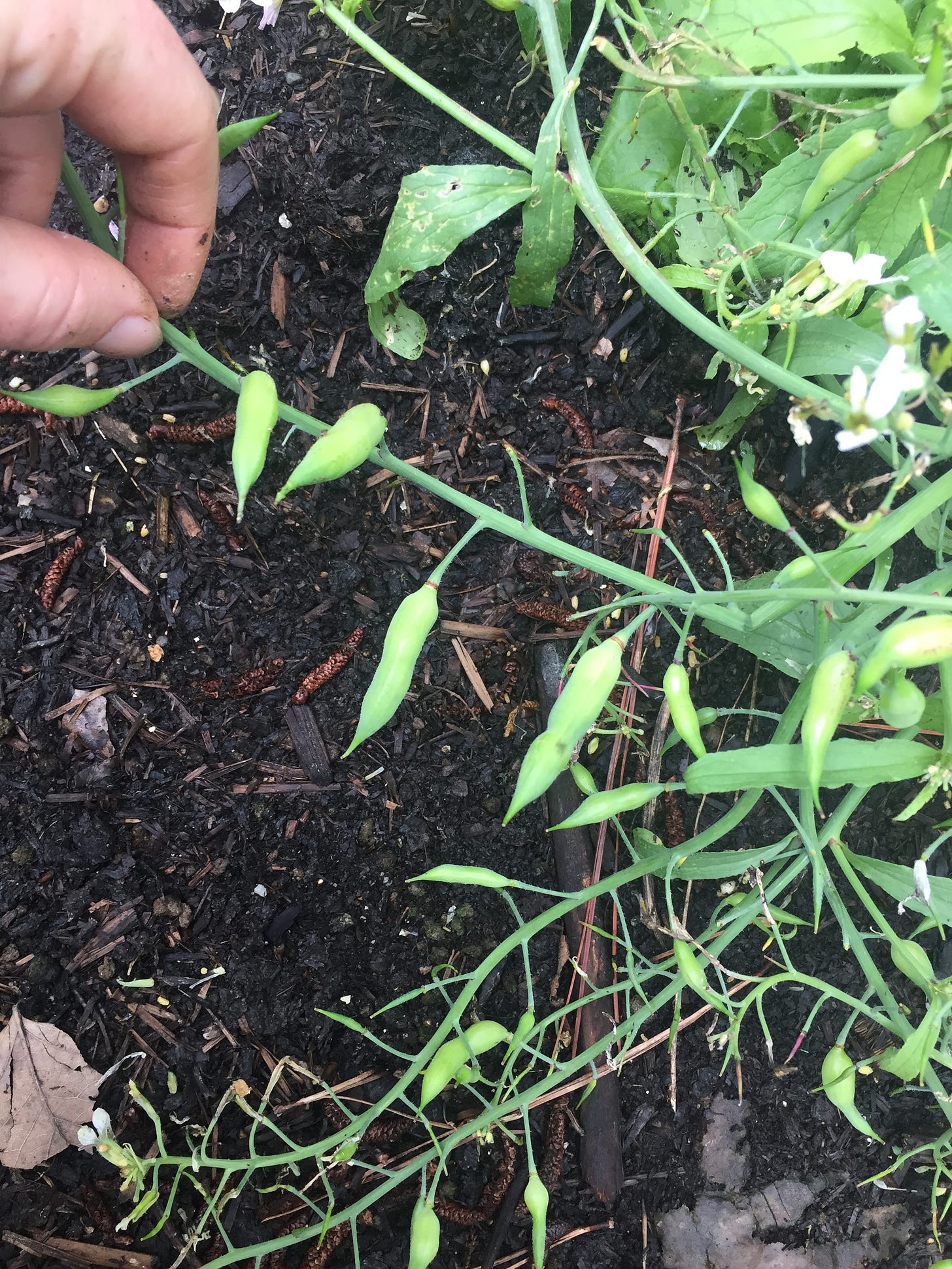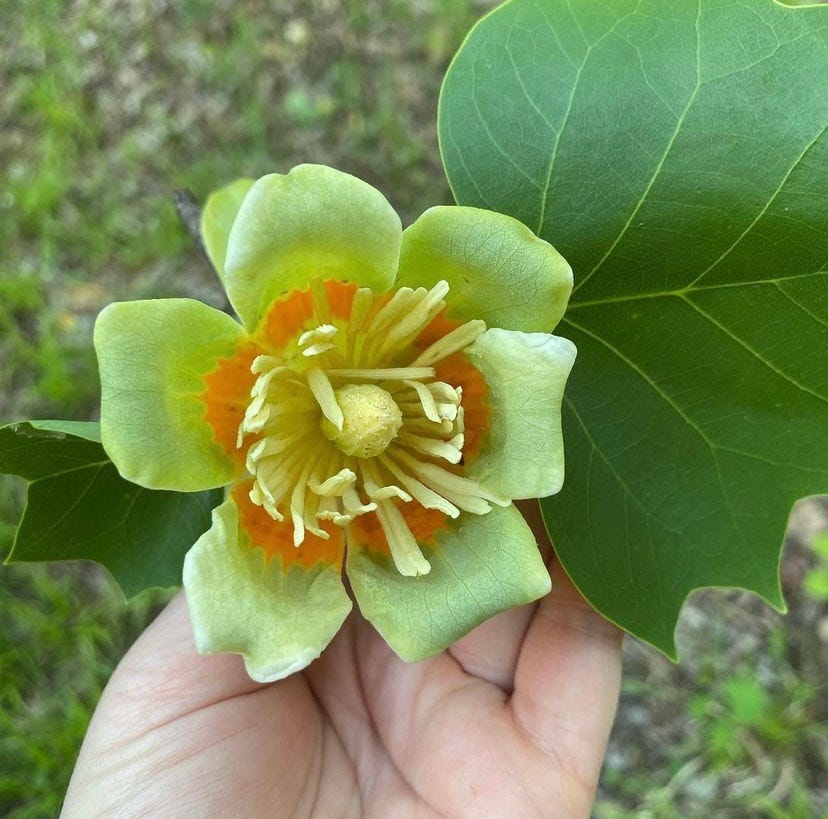7 multi-tasking plants for pollinators
Make the most from your growing space with a few plants that have multiple purposes for different pollinators.
From grass alternatives for lawns, to a nectar-producing substitute for spinach, I have several pollinator plants that you can enjoy along with the birds and bees. In case you missed it, one of my first posts on this blog was about summer forage for me and the bees. The plants I’m sharing today mature during different seasons, and some produce multiple times.
Crimson clover – I’m a huge fan of seeding crimson clover (or any clover) in lieu of lawns. I prefer crimson clover because it’s easy to sow—I walk around the yard before a good rain and throw it around me as if I’m throwing rice at a wedding—it starts to bloom in the spring and carries on for weeks into the summer, provides ornamental accents to homegrown bouquets, builds soil health by adding nitrogen, once it goes to seed it serves as food for birds, and the long stems and leaves provide wildlife habitat and materials for nests. You can also follow the “chop-and-drop” permaculture approach and use it as a living mulch, then cut it and let it compost in place. Please note crimson clover and red clover are not the same plant. Crimson clover (Trifolium incarnatum) produces a deep red blossom. Red clover (Trifolium pratense) produces a smaller purple blossom. The latter is more broadly known for its medicinal properties, use in teas, and versatility of the blossoms to be ground into a flour.
Motherwort – I started with a single motherwort seedling a few years ago and now it pops up in random places around the yard, which is a good thing to me. Motherwort is an adaptogenic herb, which means it helps to balance you and give you what you need. If you feel anxious or worried, motherwort tea helps to quell those feelings and even you out. If you feel lethargic, it helps energize you. I watch honey bees forage on motherwort all through the blooming season, and the long wands of blooms often dip down and look like they’re waving at me because fat bumblebees hop on for snacks. The post-bloom stems turn brown and snap off easily before the first frost, which provide nesting material for pollinators—both insects and birds. One of the other things I like about motherwort is that it completely dies back after the frost, which lets evergreen plants have their time to shine. At summer’s peak they provide a great privacy screen and dense foliage for more wildlife habitat. I transplanted the one seedling to my pond garden years ago. Each spring, several more pop up around the pond. I’ve noticed that the more “privacy” around the pond, the more frog song.
Radishes – Radishes probably don’t come to mind when you think of pollinator plants. If you skip harvesting radishes, they’ll bolt with a very long chain of flowers that pollinators love. Once the flowers go to seed, gather the green pods and add them to stir fries. They cook up just like peas. Another benefit: While radishes hang out in your garden, they can act as a “trap crop” since they attract flea beetles and other pests, which helps to protect your other plants for pollinators.
Rapeseed (also known as canola) – This is the only plant on my list that I haven’t grown yet. I learned a few years ago that canola produces an exemplary nutritious nectar for honeybees. According to the Honey Bee Health Coalition, “Canola provides bees an ideal habitat and efficient means of feeding. Canola fields bloom for relatively long periods and provide bees with a good source of nectar for several weeks and up to a month. The nectar has a good sugar profile for honey production and canola’s plentiful pollen offers a good balance of proteins and fats.” Even though canola doesn’t require pollination, bees allegedly love it and their pollination helps produce greater crop yields. The edible greens of canola cook just like spinach. I bought some of the greens at the farmers’ market a few years ago and they were great. Canola is often used as a cover crop after harvesting corn (which is a very heavy nitrogen feeder) and before sowing beans (which are a nitrogen fixer). An interesting merge of facts: North Dakota is home to the largest canola acreage in the United States, it’s also home to more honeybees than any state.
Tulip poplar – Tulip poplar is the primary nectar source for honey bees in the region where I live in North Carolina. Beyond honey bees, butterflies and hummingbirds rely on poplar nectar too. I see Eastern Tiger Swallowtails flying in the poplar canopy throughout the spring. While these trees produce a significant nectar flow, they also grow rapidly. Poplar is a soft wood used in furniture, and it also burns fast. As a fuel source, you can use it in advance of waiting for other woods to season, or mix it with slower-burning woods to help slow consumption of total wood reserves.
Comfrey – So many people have warned me about comfrey’s rooting resilience that I’ve been to scared to plant it in my yard. All of my comfrey plants are in containers while I continue to be thoughtful in the best placement for the plants. Comfrey’s tap roots are known to grow 12 feet, so once you make a home for it—it won’t leave. This is good though because pollinators love the delicate purple flowers. Because of that long root, comfrey pulls up nutrients from deep in the earth and helps make it available for neighboring plants. Following that “chop-and-drop” approach helps to keep the plant trim, while letting the cut leaves release nutrients to the mulched plants. One of the most remarkable things (to me, at least) is that comfrey is a rare plant that produces B12. The nutrient profile also makes it a helpful medicinal plant.
Blueberries – I’m slowly expanding our blueberry patch, which has been growing for five years and has yet to produce a harvest. The poor production is a result of my own error. I didn’t know at the time of planting that you need to plant multiple varieties of blueberries for them to pollinate. My error hasn’t stopped the bees from enjoying the existing plants, but hopefully with the extra varieties I’m planting this fall there will actually be a harvest of berries for us and the birds (feathered pollinators).
Do you already have these plants working your landscape?






